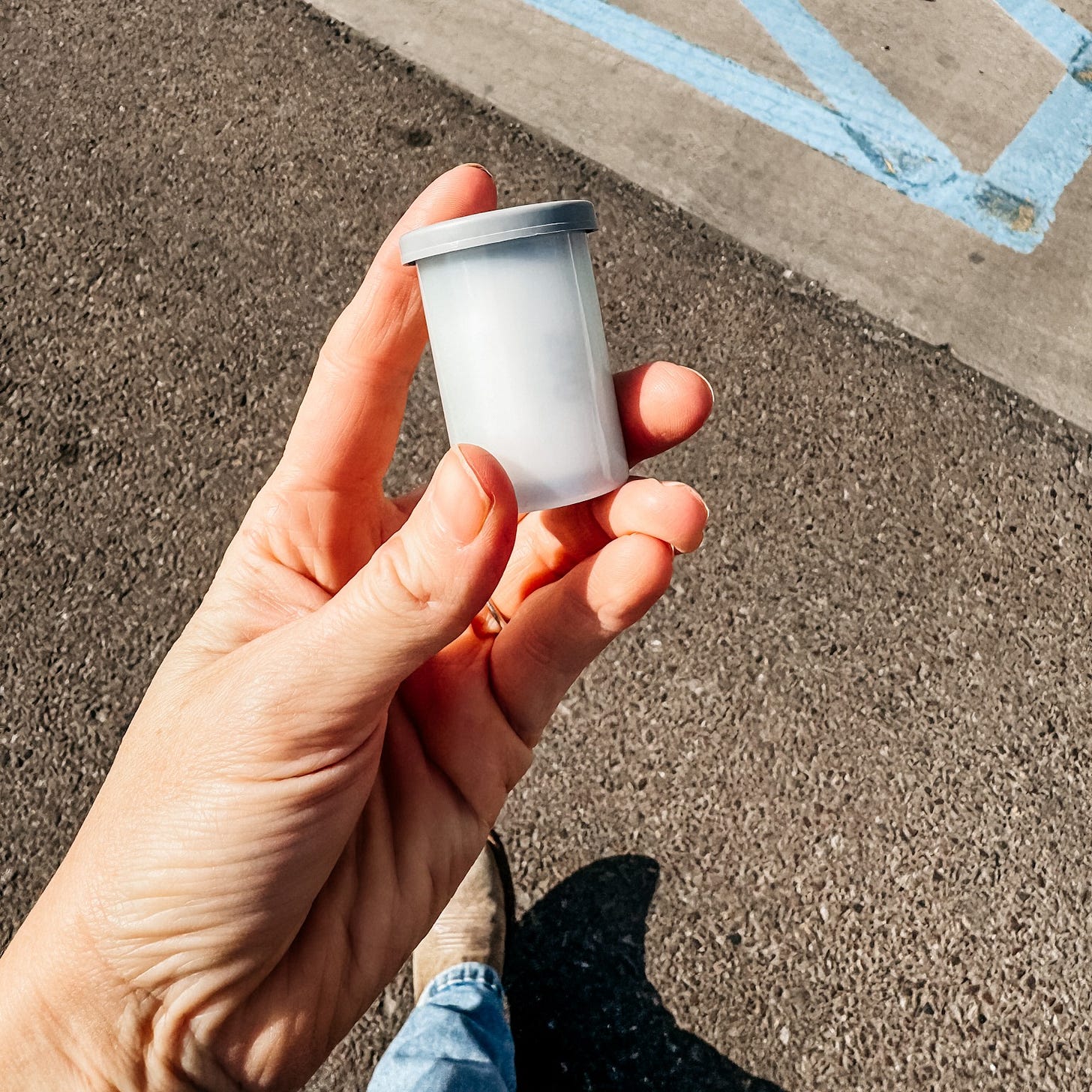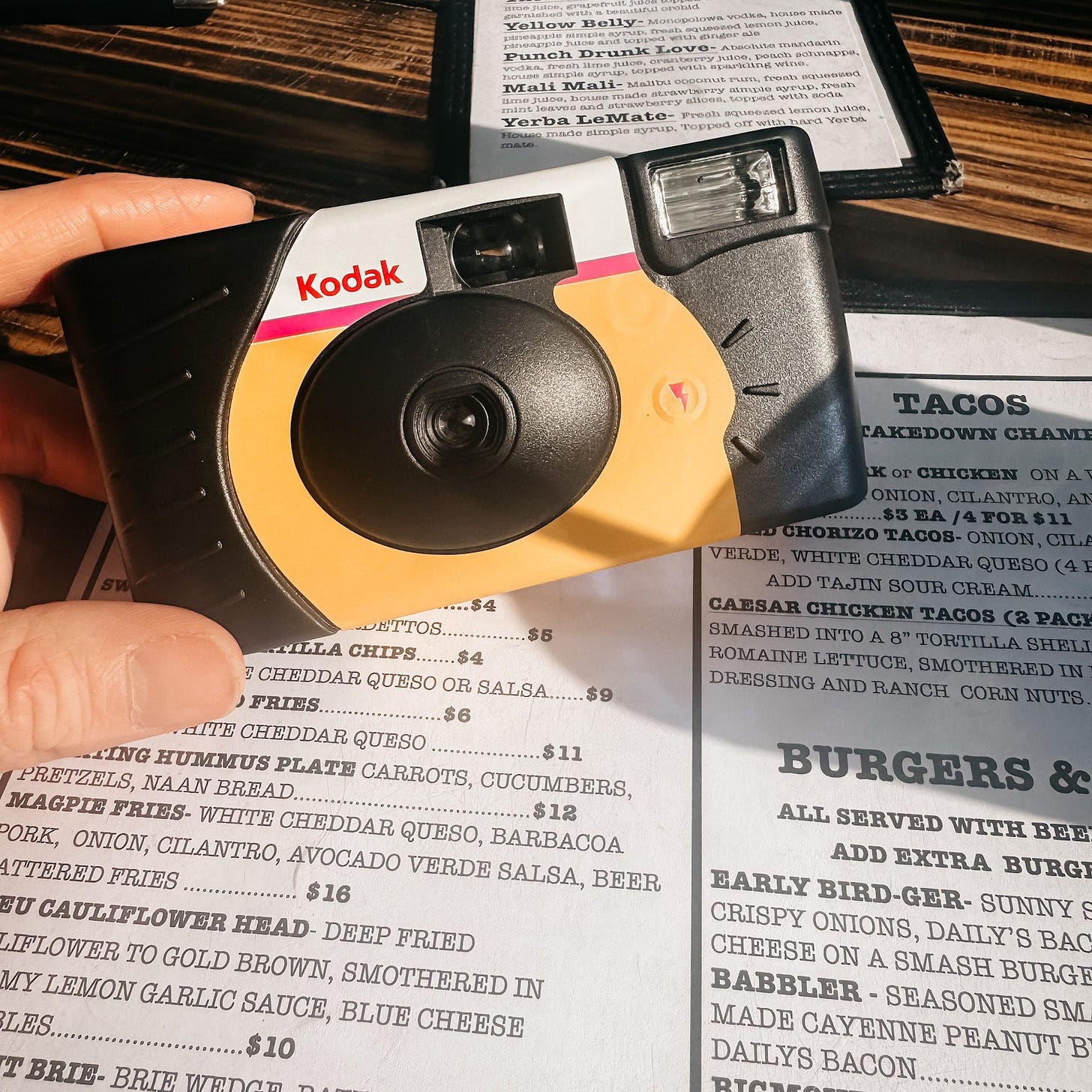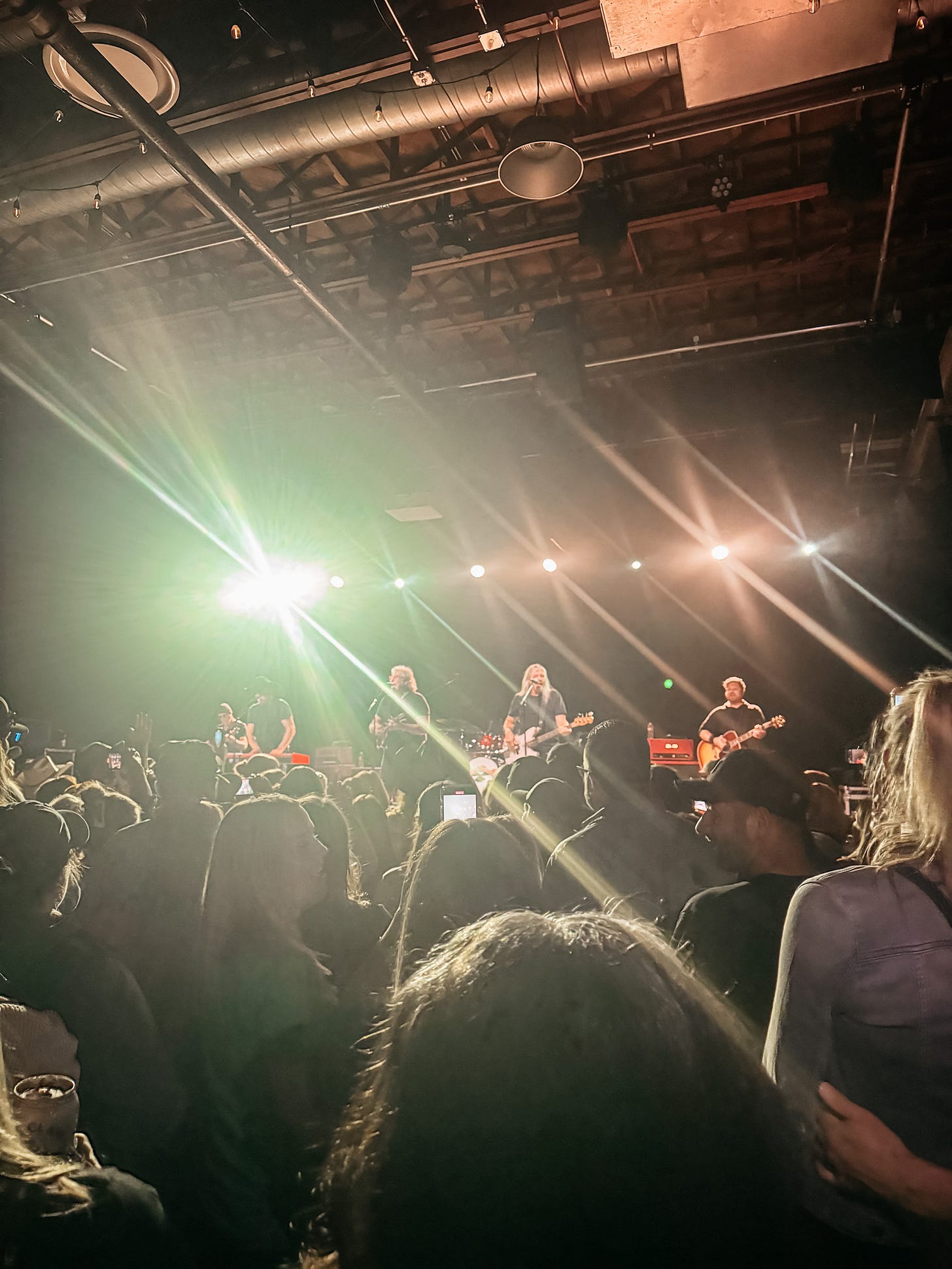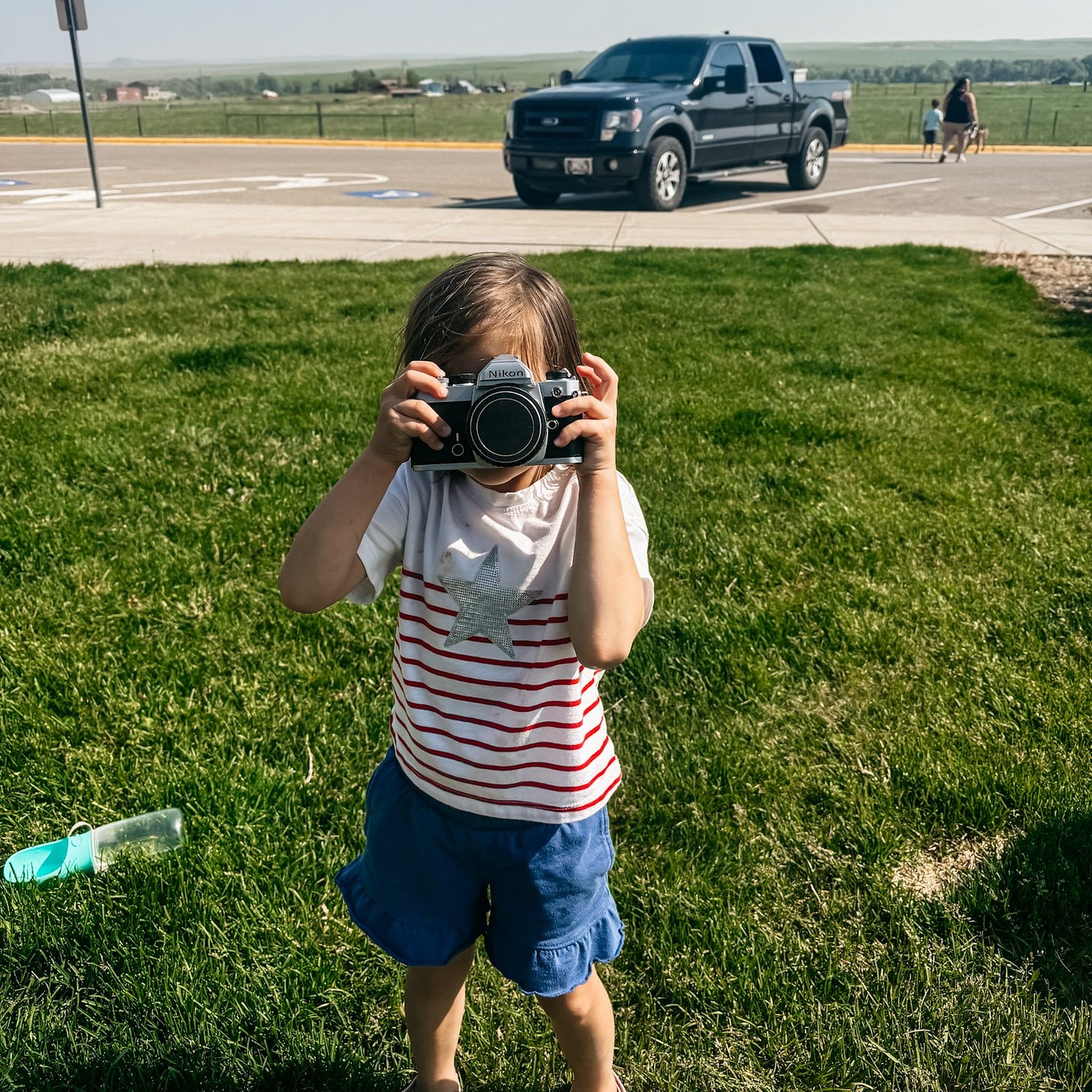Last week, I dropped off a roll of film to be developed. The first roll I’ve shot in over 20 years. I walked away from Walgreens feeling a mix of excitement and nerves. Would any of the pictures turn out? What if the whole roll is trash? But there was nothing I could do about it; it was out of my hands. It’s possible that every photo will be terrible, but I won’t know for four to six weeks—the amount of time the woman at Walgreens told me it would take to get my pictures back.1
A few months ago, I signed up for a “100 Days of Summer on Film” workshop. As soon as I saw the workshop, I knew I wanted to borrow my mom’s 35mm camera, the one she took all our pictures with when I was growing up. I felt a sense of nostalgia before I even loaded my first roll of film into her old Nikon. How many times did my sister and I crowd around my mom, begging to see the pictures she took weeks, or maybe months earlier? My sister and I would laugh at the funny faces we pulled, while my mom looked on, possibly annoyed, remembering how she had asked for “Just one nice picture!” Eventually, I got my own camera, taking pictures of my friends, the family dog, and anything else I deemed worthy of a photograph. (Which was often not picture worthy.)
For years, my whole childhood, film cameras were all we had. I don’t remember when I got my first digital camera; I was probably in high school. Loading a roll of film was easy; I knew what I was doing. I’d never experienced seeing a photo taken in real time, which is now second nature to me—the instant gratification of seeing an image on the phone screen or the back of a digital camera. The endless number of pictures we can take. When my mom loaned me her film camera this spring, I had to teach myself how to load the film roll and adjust the settings. I was terrified I would ruin the roll before I even took my first photo. Over the next few weeks, I took 36 photos, and I have no idea if any of them turned out. Scary, right? It’s not a feeling I’m used to anymore.
While dropping off the roll of film, I bought a disposable camera to take with me to the BlackHawk concert we were on our way to. It felt fitting to bring a disposable camera to a ‘90s concert. During dinner, before the concert, the server asked if she could take a picture of our group. “I’ve been eyeing that camera on your table all night!” she said. I laughed and handed her the camera, and she snapped a couple of photos—the six of us caught on film. I didn’t pull out my phone when she was done. I didn’t ask her to take another one “just in case.” It felt like enough to just let the moment be. If the pictures turn out, great. If not, I’ll remember trying to take our picture before the concert with a disposable camera, and how one of our friends said, “You’ve gone full 1992, Stacy!”
After dinner, I tucked the camera into my purse and we headed into the concert venue. Once we were all inside, I waited in line for a beer, and while standing there, someone grabbed my arm. At first, I thought it was someone brushing by, trying to squeeze between the line. But then, I realized it was intentional, not just someone walking past. I turned around and saw my friend Jesse, a woman I’d only met once before in real life, since “meeting” on Instagram several years ago. We chatted for a minute, and before she walked away with her husband, I pulled out the disposable camera and snapped the first photo of the two of us.
During the concert, I took several photos of my friends singing along to BlackHawk, the words all coming back to us, as if the ‘90s were just yesterday, not thirty years ago. When the concert was nearing the end, I asked a stranger behind us to take our picture. I’m sure she expected me to hand her a familiar phone, but instead, I placed the bright yellow Kodak in her hand. She laughed, then pressed her face against the viewfinder, snapping a photo—the flash blinding us in the dark venue. She asked if we wanted her to take another picture, and I yelled over the music, “Sure!” She tried to take another picture, but before she could, she remembered she had to wind the camera to advance the film.
By the end of the night, the running joke was, “You can see the picture in four to six weeks!” I took two photos on my phone the whole night. The rest I left up to chance on the disposable camera.
On the way home, I noticed the strawberry moon rising over the prairie. I only knew it was a Strawberry Moon because someone had shared about it on Facebook earlier in the day. I told Rich, “Pull over, I want to take a picture!” He said, “You know that’s not going to turn out, right?” I nodded, but told him I wanted to do it anyway. He stopped on the gravel road, and I jumped out of the pickup, pointing my Kodak toward the sky, toward the pink moon. I snapped the picture and then got back into the pickup. We laughed about how, as kids, we would excitedly take pictures of random objects, things we didn’t want to forget—like a full moon. I’m sure we thought it was going to be the greatest picture ever, imagining ourselves as amazing photographers, about to capture the best photo. We were Ansel Adams in training, with our five-dollar disposable cameras.2 And weeks later, we would be highly disappointed when the film was developed, flipping through the stack of photos looking for that amazing shot, only to ask ourselves… What is this?
But I wanted to try, even though I knew the picture of the moon would likely be garbage. I wanted to take the picture and then forget about it. I wanted to experience flipping through a stack of photos, then pausing at the nearly black image, laughing at how terrible it is. Is that the moon? I’ll remember how I made Rich stop on the road, so I could take the photo in my bare feet, my cowboy boots kicked off on the floor of the pickup, my feet sore from dancing in boots I only wear a handful of times each year.
My kids had never seen a non-digital camera until a month ago, when I started using my mom’s old camera. Each time I take their picture, they ask, “Can I see?” And I remind them we have to wait. I remind them I can’t take multiple pictures. They still don’t fully understand, and to be honest, I still don’t completely understand how film works either. It’s kind of like magic.
Magic like how we meet people online today. People whom we might eventually call friends.
During the concert, I saw another woman there, a woman I recognized from, you guessed it, Instagram. It’s sort of a strange world we live in, right? A couple of months ago, she started following me; I assumed because of something I wrote. When I realized she lived in my part of the state, and that we had some things/people in common, I followed her back. We’ve never messaged or talked. But it felt weird to be in the same place as her, knowing that we “know” each other, and not to say hello. Isn’t the point of social media... to be social?
Usually, I’m the last person to introduce myself to someone, to step out of my comfort zone. I’m an introvert, full stop. But maybe, because of the ‘90s vibe I was going for (or maybe, the beer), I stopped and said hello to her on my way to the bathroom. “I, um, think we follow each other on Instagram? I’m Stacy!” I felt like a crazy person. What if she didn’t even know who I was? How embarrassing! What if I had the wrong person? But after a second, recognition hit, and she said, “Oh, hi! Yes! Nice to meet you!” Later, she DM’d me on Instagram, and told me she was glad I said Hello.
For the most part, I’m grateful for the technology we have today. The fact that my kids can (and do) FaceTime my parents nearly every day. They’re able to see each other, even though they live in different states. I’ve made friends online that I never would have met if it weren’t for the Internet. I’m able to write and share here because of the Internet. And all the other countless ways technology has changed the way we live.
But I think every generation feels the same way—we miss the way things used to be. We’re the old man standing on the front lawn, raising our canes, yelling, “Get off my lawn! Kids these days!” We proclaim, “Our generation was the best!”3
I do miss some a lot of what we had before all this technology. I do wonder how it will, and is, shaping my kids’ childhoods and their futures. I know we can never go back to the way things were; it can’t be shoved back in the bottle. But the film cameras have been a fun way to play in the past, to slow things down, even if just for a minute. It’s a way to help me notice, and maybe teach my kids to notice, too.
Of course, most of my days are rooted in the present; it’s not a complete ‘90s summer around here. I would have to give up my cell phone and cut the Internet to live a total ‘90s summer. But it’s fun to remember what it was like to take a photo and have to wait to see how it turns out, knowing it might be complete garbage, but pausing to capture the moment anyway.
And with any luck, I’ll be back to share the photos—in four to six weeks, that is.
Since then, I called Walmart, and they process film, and said it takes about two weeks. I will be dropping off my next roll of film there!
Sidenote: Disposable cameras today are NOT that cheap. Apparently, we have to pay for nostalgia.
But really, it’s hard to top the 90s/early 2000s, but I digress. I am that old man on the lawn.






I can’t wait to see the photos! I love how you worded it “play in the past” I’ve been trying so hard to give my kids a 90s summer, honestly a 90s childhood and I have realized real quick they are in the minority. But I’m not mad about it, I think we are doing them a big favor!
I love anything 90s nostalgia! This post was so fun to read and I look forward to seeing the pics :)